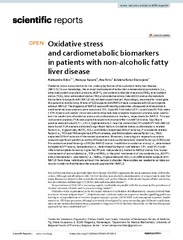Приказ основних података о документу
Oxidative stress and cardiometabolic biomarkers in patients with non-alcoholic fatty liver disease
| dc.creator | Klisić, Aleksandra | |
| dc.creator | Kavarić, Nebojsa | |
| dc.creator | Ninić, Ana | |
| dc.creator | Kotur-Stevuljević, Jelena | |
| dc.date.accessioned | 2021-09-29T09:33:35Z | |
| dc.date.available | 2021-09-29T09:33:35Z | |
| dc.date.issued | 2021 | |
| dc.identifier.issn | 2045-2322 | |
| dc.identifier.uri | https://farfar.pharmacy.bg.ac.rs/handle/123456789/3969 | |
| dc.description.abstract | Oxidative stress is assumed to be the underlying feature of non-alcoholic fatty liver disease (NAFLD). To our knowledge, the mutual involvement of redox status homeostasis parameters [i.e., advanced oxidation protein products (AOPP), pro-oxidant-antioxidant balance (PAB), total oxidant status (TOS), total antioxidant status (TAS) and oxidative-stress index (OSI)] and cardiometabolic biomarkers in subjects with NAFLD has not been examined yet. Accordingly, we aimed to investigate this potential relationship. A total of 122 subjects with NAFLD were compared with 56 participants without NAFLD. The diagnosis of NAFLD was confirmed by abdominal ultrasound. Anthropometric and biochemical parameters were measured. OSI, Castelli’s Risk Index I (CRI-I) and Castelli’s Risk Index II (CRI-II) were calculated. Univariate and multivariate binary logistic regression analysis were used to test the predictions of oxidative stress and cardiometabolic markers, respectively for NAFLD. Principal component analysis (PCA) was applied to explore its mutual effect on NAFLD status. Significant positive associations of CRI-I, CRI-II, high sensitivity C-reactive protein (hsCRP) and AOPP with NAFLD were found. PCA analysis extracted 3 significant factors: Oxidative stress-cardiometabolic related factor (i.e., triglycerides, AOPP, HDL-c and HbA1c)-explained 36% of variance; Pro-oxidants related factor (i.e., TOS and PAB)-explained 17% of variance; and Antioxidants related factor (i.e., TAS)- explained 15% of variance of the tested parameters. Moreover, binary logistic regression analysis revealed significant predictive ability of Oxidative stress-cardiometabolic related factor (p < 0.001) and Pro-oxidants related factor (p < 0.05) for NAFLD status. In addition to oxidative stress (i.e., determined by higher AOPP levels), dyslipidemia (i.e., determined by higher lipid indexes: CRI-I and CRI-II) and inflammation (determined by higher hsCRP) are independently related to NAFLD status. The mutual involvement of pro-oxidants (i.e., TOS and PAB), or the joint involvement of pro-oxidants (i.e., AOPP) and cardiometabolic parameters (i.e., HbA1c, triglycerides and HDL-c) can differentiate subjects with NAFLD from those individuals without this metabolic disorder. New studies are needed to validate our results in order to find the best therapeutic approach for NAFLD. | |
| dc.publisher | Nature Research | |
| dc.relation | info:eu-repo/grantAgreement/MESTD/inst-2020/200161/RS// | |
| dc.rights | openAccess | |
| dc.rights.uri | https://creativecommons.org/licenses/by/4.0/ | |
| dc.source | Scientific Reports | |
| dc.title | Oxidative stress and cardiometabolic biomarkers in patients with non-alcoholic fatty liver disease | |
| dc.type | article | |
| dc.rights.license | BY | |
| dcterms.abstract | Клисић, Aлександра; Нинић, Aна; Котур-Стевуљевић, Јелена; Каварић, Небојса; | |
| dc.citation.volume | 11 | |
| dc.citation.issue | 1 | |
| dc.citation.rank | M21 | |
| dc.identifier.wos | 000696635300091 | |
| dc.identifier.doi | 10.1038/s41598-021-97686-6 | |
| dc.identifier.scopus | 2-s2.0-85115201804 | |
| dc.identifier.fulltext | https://farfar.pharmacy.bg.ac.rs/bitstream/id/9210/Oxidative_stress_and_pub_2021.pdf | |
| dc.type.version | publishedVersion |

